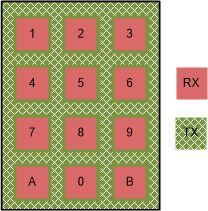TIDUE90 July 2018
- Description
- Resources
- Features
- Applications
- Design Images
- 1System Description
- 2System Overview
- 3Hardware, Software, Test Requirements, and Test Results
- 4Design Files
- 5Software Files
- 6Related Documentation
- 7About the Author
2.4.2 Mutual Capacitance Shielding
A mutual capacitance sensor requires a RX electrode and a TX electrode. Typically, mutual capacitive electrodes can be multiplexed with other mutual capacitive electrodes. This means that more than one button can share a common signal. However, to optimize the sensor design for liquid tolerance, the design needs a driven shield to protect the sensors from coupling to surrounding ground or other components. To accurately detect the touched sensor during heavy continuous liquid flow, the design should have an individual RX signal for each sensor instead of multiplexing the RX signal with other sensors.
Unlike in the self capacitance electrode design, in which the hatched filling connects to a CapTIvate I/O for the driven shield, in mutual capacitance mode, the hatched filling connects to the TX signal. This hatched filling is used as a driven shield to protect all of the sensors and the shared TX electrode for all the sensors. For each individual RX electrodes, use a solid pad instead of hollow traces to protect the sensors from coupling to the ground or other components on other layers of the PCB. All of these recommendations about the design of mutual capacitance sensors are optimized for a keypad application that can operate reliably when exposed to heavy continuous liquid flow.
Figure 10 shows the layout of the 12-button keypad. For more details on the layout design, refer to Section 4.3 or download the design files from the TIDM-1021 page.
 Figure 10. 12-Button Keypad Mutual Capacitance Design Layout
Figure 10. 12-Button Keypad Mutual Capacitance Design Layout